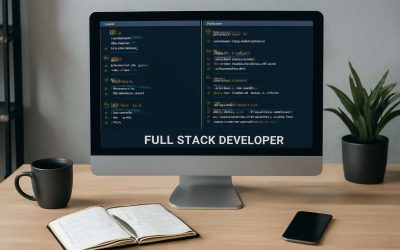Understanding Full Stack Development Errors
Types of Errors in Full Stack Development – Common coding and logical errors developers face
In the intricate dance of full stack development, errors are inevitable, yet they often reveal the true depth of a developer’s craft. A full stack developer error makes clever use of debugging and problem-solving, transforming setbacks into opportunities for innovation. Understanding the various types of errors that can arise is essential for mastering this art.
Common coding errors include syntax mistakes, such as misplaced brackets or misspelled variables, which can cause immediate crashes or unpredictable behaviour. Logical errors, on the other hand, tend to be subtler—these are flaws in the thought process behind the code, leading to unexpected results or data inconsistencies.
Sometimes, these issues manifest as server malfunctions or front-end glitches—each demanding a keen eye and a strategic approach. Recognising the difference between these error types empowers developers to craft solutions that are not only clever but resilient. After all, a full stack developer error makes clever when it turns obstacles into stepping stones for greater mastery.
Impact of Errors on Project Progress – How errors can delay deployment and affect user experience
Errors in full stack development are more than mere inconveniences—they can significantly impact project timelines and user satisfaction. When a full stack developer error makes clever, it often leads to delays in deployment, as debugging and fixing issues consume valuable time. These setbacks can ripple across the project, causing missed deadlines and increased costs.
Unresolved errors may also deteriorate user experience, resulting in frustration and loss of trust. For instance, front-end glitches or server malfunctions, if not addressed swiftly, can tarnish the reputation of an application. Recognising how errors influence project progress underscores the importance of vigilant testing and proactive troubleshooting.
In essence, a full stack developer error makes clever when it transforms these challenges into opportunities for refining skills and strengthening the project’s resilience. Understanding the profound impact of errors helps developers approach debugging with strategic patience and precision.
Importance of Error Handling and Debugging – Strategies for efficient error detection and resolution
In the labyrinth of full stack development, errors are inevitable, yet their significance extends beyond mere bugs—they reveal our collective struggle with complexity and mastery. Recognising the importance of error handling and debugging is paramount; it’s not just about fixing faults but understanding the deeper architecture of our craft. A full stack developer error makes clever when it transforms setbacks into opportunities for growth, honing both technical skill and resilience.
Effective error detection relies on a keen eye and strategic tools. Implementing comprehensive logging, automated testing, and real-time monitoring creates a safety net that catches issues early. Remember, the most profound insights often emerge from silent failures. For those seeking a sharper edge, consider prioritising the following:
- Consistent code reviews to identify anomalies before they escalate
- Utilising debugging tools tailored for both front-end and back-end troubleshooting
- Creating a culture where errors are viewed as learning moments rather than setbacks
When a full stack developer error makes clever, it becomes a catalyst for refinement. It’s about cultivating patience and precision—qualities that elevate debugging from a mundane task to a strategic act of craftsmanship. Embracing this mindset ensures that each error, no matter how disruptive, ultimately contributes to a more resilient and sophisticated application.
Clever Error Management Strategies for Full Stack Developers
Proactive Error Prevention Techniques – Code reviews, unit testing, and static analysis tools
In the intricate ballet of modern development, where lines of code intertwine like threads in a tapestry, even the most seasoned full stack developer error makes clever. Yet, amidst this chaos, there are strategies that act as vigilant guardians—proactive error prevention techniques that serve as the first line of defence. By harnessing the power of code reviews, unit testing, and static analysis tools, developers can spot potential pitfalls before they morph into catastrophic failures.
These techniques function as a symphony of safeguards, ensuring that vulnerabilities are addressed in the embryonic stage. Code reviews, for instance, act as a second pair of eyes—an almost poetic ritual where seasoned developers scrutinise every line for lurking flaws. Meanwhile, unit testing creates a safety net, catching logical errors that could otherwise slip through the cracks. Static analysis tools, on the other hand, serve as silent sentinels, analysing code for anomalies and enforcing best practices with relentless precision.
- Early detection of bugs
- Reduction of technical debt
- Enhanced code quality and maintainability
When these techniques are woven into the fabric of development, they transform the process from a frantic scramble to a calculated dance—where full stack developer error makes clever, and errors are nipped in the bud before they bloom into chaos. It’s a testament to the art of foresight, turning potential disasters into mere whispers of the past.
Effective Debugging Practices – Using debuggers, console logs, and error tracking software
In the labyrinthine world of full stack development, where every line of code is a vital thread in a grand tapestry, even the most experienced craftsman encounters unexpected flaws. A staggering 70% of bugs are caught only during runtime, underscoring the necessity of meticulous debugging practices. To navigate this complex terrain, full stack developers employ clever error management strategies that transform chaos into clarity.
Effective debugging practices—using sophisticated debuggers, insightful console logs, and comprehensive error tracking software—are the trusty lanterns illuminating hidden bugs lurking in the shadows of your code. These tools enable developers to trace errors precisely where they occur, reducing the time spent chasing phantom issues. When combined with a keen eye for anomalies and a systematic approach, full stack developer error makes clever, turning potential pitfalls into opportunities for optimisation.
Automating Error Detection – CI/CD pipelines and automated testing to catch errors early
In the intricate dance of full stack development, errors are inevitable—yet how we manage them can turn potential chaos into a symphony of optimisation. A remarkable 70% of bugs are only revealed during runtime, highlighting the importance of clever error management strategies. Full stack developer error makes clever when harnessing automation to detect flaws early in the development lifecycle.
Advanced CI/CD pipelines and automated testing frameworks serve as vigilant sentinels, continuously scrutinising code for anomalies before they reach production. These systems not only accelerate the feedback loop but also ensure that errors are caught swiftly, reducing costly delays. By integrating these tools seamlessly into their workflow, developers create a fortress of resilience around their codebase, transforming error detection from a reactive chore into a proactive art.
- Continuous Integration (CI) systems running automated tests
- Pre-deployment static analysis tools
- Real-time error tracking integrated with deployment pipelines
This clever orchestration of automation underscores a core truth: in full stack development, error makes clever when it is anticipated, intercepted, and managed with precision.
Common Clever Mistakes Made by Full Stack Developers
Mismanagement of State and Data – State handling errors in frontend and backend
In the chaotic universe of full stack development, mismanagement of state and data remains a notorious culprit behind elusive bugs and unpredictable behaviour. It’s like trying to juggle flaming torches while riding a unicycle—except your torches are user sessions and your unicycle is the backend database. Full stack developer error makes clever, but often overlooked, mistakes in handling state can turn a sleek application into a digital soap opera.
One of the most common pitfalls is inconsistent state synchronization—imagine your frontend displaying data that the backend has already decided to forget. This inconsistency can cause a cascade of errors, from misplaced user inputs to data corruption. In the backend, poor data management often manifests as race conditions or stale data that bafflingly persists even after updates. The key to avoiding these pitfalls? Recognising that state isn’t just a fleeting concept but the backbone of a reliable, user-friendly app. Ensuring seamless data flow between frontend and backend is where full stack developer error makes clever—or painfully obvious—mistakes.
Security Oversights – Common security mistakes leading to vulnerabilities
In the shadowed corridors of full stack development, security oversights lurk like spectral predators waiting to pounce. A single lapse in safeguarding user data can transform your pristine application into a haunted house of vulnerabilities. Full stack developer error makes clever—yet often insidious—mistakes that leave doors wide open for malicious intruders.
One of the most common is inadequate input validation, which can allow SQL injection or cross-site scripting (XSS) to seep through unseen. Developers sometimes underestimate the importance of sanitising user input, inadvertently creating a gateway for chaos. Remember, in this dark realm of code, the failure to implement proper authentication and authorisation measures can turn a seemingly secure application into a playground for cyber marauders. Vigilance is paramount—because when security is compromised, the repercussions echo through the digital abyss with devastating clarity.
Performance Pitfalls – Inefficient database queries and memory leaks
In the labyrinthine world of full stack development, even the most seasoned developers can stumble into performance pitfalls that seem sneaky enough to outwit debugging. One of the most common full stack developer error makes clever is neglecting to optimise database queries. It’s easy to assume that a quick fetch won’t matter—until your application slows to a crawl, turning user experience into a test of patience. Inefficient queries can cause server bottlenecks, leading to sluggish response times and an unhappy user base.
Memory leaks are another insidious trap, quietly siphoning resources and causing crashes in the most inconvenient moments. Sometimes, developers inadvertently hold onto objects longer than necessary or forget to close database connections, creating a cascade of performance woes. These errors often hide behind the guise of code complexity, making them tricky to detect without vigilant profiling. When full stack developer error makes clever, it’s often these silent resource hogs that cause the biggest headaches, turning what seems like a minor oversight into a major bottleneck.
Leveraging Clever Solutions to Overcome Development Errors
Implementing Robust Error Handling – Try-catch blocks, fallback UI, and error boundaries
In the unpredictable realm of full stack development, errors are more than mere setbacks—they’re opportunities to demonstrate ingenuity. When a full stack developer error makes clever, it transforms a potential crisis into a showcase of resilience. Implementing robust error handling isn’t just about catching mistakes; it’s about designing a safety net that keeps systems resilient under pressure.
Try-catch blocks serve as the first line of defence, gracefully intercepting exceptions before they escalate. But clever developers go beyond basics—they craft fallback UI components that inform users without revealing sensitive information, maintaining trust even when things go awry. Error boundaries, especially in React applications, act like vigilant guardians, isolating faults and preventing leaks into the entire app ecosystem.
By strategically leveraging these techniques, full stack developer error makes clever. It’s about creating a layered approach that anticipates failures and responds seamlessly. Such proactive measures ensure that when errors inevitably occur, they become mere blips on the radar—manageable, contained, and ultimately, a testament to a developer’s mastery of error mitigation strategies.
Using Modern Frameworks and Libraries – Tools that minimize common bugs
In the fast-paced world of full stack development, leveraging clever solutions to overcome errors isn’t just an option—it’s essential. Modern frameworks and libraries have revolutionised how developers handle bugs, minimising common pitfalls that can derail projects. For example, tools like React’s error boundaries or Vue’s error handling hooks act as sophisticated safety nets, catching faults before they cascade into larger issues. These solutions embody the cleverness that full stack developer error makes clever, transforming potential setbacks into opportunities for seamless user experience.
Additionally, automation plays a pivotal role. Continuous Integration/Continuous Deployment (CI/CD) pipelines automatically run tests and static analysis, catching errors early in the development cycle. This proactive approach ensures that bugs aren’t just detected; they’re pre-empted, reducing downtime and elevating code quality. By integrating such modern tools, developers craft a resilient architecture that anticipates failures—making error management an elegant dance rather than a chaotic scramble. Ultimately, these clever techniques empower full stack developers to deliver robust applications, even amidst the inevitable storm of bugs and glitches.
Adopting a DevOps Mindset – Continuous monitoring and real-time error analytics
In the relentless pursuit of flawless applications, full stack developer error makes clever strategies not just a luxury but a necessity. Embracing a DevOps mindset transforms error management from a reactive chore into a proactive art form. Continuous monitoring tools, such as real-time error analytics, serve as vigilant sentinels—detecting anomalies as they unfold and providing instant insights. This constant vigilance allows developers to intervene swiftly, often before users even notice an issue. By integrating these modern techniques, teams can pre-empt failures and maintain a seamless user experience, even amid the chaos of unpredictable bugs.
These smart practices foster a resilient development environment. For instance, implementing a layered approach—combining automated alerts with detailed dashboards—ensures no error slips through unnoticed. An ordered list of critical steps might include:
- Continuous real-time monitoring
- Robust error analytics platforms
- Immediate automated alerts for anomalies
Such measures exemplify how full stack developer error makes clever solutions a cornerstone of successful project management. Mastering this approach not only reduces downtime but also elevates the overall robustness of the application, proving that in the world of full stack development, cleverness is often the key to staying ahead of potential pitfalls.
Emerging Trends in Error Management for Full Stack Developers
Artificial Intelligence and Machine Learning – Predictive error detection and automated fixes
In the relentless pursuit of perfection, full stack developer error makes clever leaps forward as emerging trends harness the power of artificial intelligence and machine learning. These sophisticated tools are revolutionising error management, transforming chaos into clarity with predictive error detection. Imagine a system that not only anticipates potential pitfalls but also deploys automated fixes before a single user notices—the future of error handling is unfolding before our very eyes.
By integrating AI-driven insights into development workflows, developers can now employ predictive analytics that serve as an early warning system. This proactive approach reduces downtime and enhances user satisfaction. Furthermore, machine learning algorithms continually learn from past mistakes, refining error detection processes with each iteration. Such innovations are paving pathways for full stack developer error makes clever a reality, where errors are not merely caught but anticipated and elegantly resolved.
As these technologies evolve, the landscape of error management becomes more intuitive and responsive. The fusion of human ingenuity with intelligent automation heralds a new era—one where errors are not the end of progress, but a stepping stone towards more resilient, seamless software ecosystems.
Serverless Architectures – Reducing error surfaces with managed services
In the rapidly shifting landscape of modern software architecture, the advent of serverless architectures signifies a profound shift in how errors are encountered and managed. By reducing the surface area for error in traditional server-dependent setups, managed services act as a double-edged sword—streamlining operations while subtly obscuring potential fault lines. For the full stack developer error makes clever when leveraging these architectures, as the intricacies of distributed components demand a nuanced approach to error mitigation.
Through the utilisation of cloud-native solutions—such as managed databases, event-driven functions, and API gateways—error surfaces are inherently diminished. This not only simplifies debugging but also shifts the focus towards more sophisticated, anticipatory error management strategies. Instead of wrestling with sprawling logs and scattered anomalies, developers can harness real-time insights that offer a panoramic view of system health. The seamless integration of these tools transforms error handling from a reactive chore into a proactive art form.
Moreover, embracing serverless paradigms compels full stack developers to rethink error paradigms altogether. The emergent trend of adopting managed services enables a shift from error correction to error prevention—an evolution where the full stack developer error makes clever by designing systems that anticipate failure modes before they manifest. As a result, errors become less frequent and more manageable, paving the way for resilient, scalable solutions that gracefully absorb inevitable imperfections.
Collaborative Debugging Tools – Real-time collaboration platforms for error resolution
In an era where software complexity accelerates at breakneck speed, collaborative debugging tools are revolutionising how full stack developers error makes clever. Real-time platforms like shared IDEs, live error tracking, and instant messaging enable teams to pinpoint issues swiftly and efficiently. This shift not only accelerates resolution times but also fosters a culture of transparency and shared responsibility, making error management less of a solo chore.
By integrating these tools into their workflow, full stack developers error makes clever as they leverage collective intelligence to identify root causes before problems escalate. Moreover, the adoption of visual dashboards and integrated chat features provides immediate context, transforming error resolution into a team effort that’s both dynamic and precise. This collaborative approach ultimately streamlines debugging and enhances system resilience in an increasingly interconnected development environment.




0 Comments